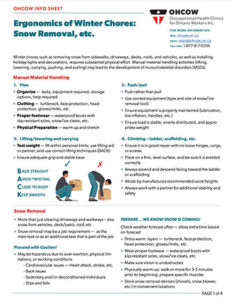 Winter chores such as removing snow from sidewalks, driveways, decks, roofs, and vehicles, as well as installing holiday lights and decorations, requires substantial physical effort. Manual material handling activities (lifting, lowering, carrying, pushing, and pulling) may lead to the development of musculoskeletal disorders (MSDs).
Winter chores such as removing snow from sidewalks, driveways, decks, roofs, and vehicles, as well as installing holiday lights and decorations, requires substantial physical effort. Manual material handling activities (lifting, lowering, carrying, pushing, and pulling) may lead to the development of musculoskeletal disorders (MSDs).
Also hear the accompanying podcast here.
Winter chores such as removing snow from sidewalks, driveways, decks, roofs, and vehicles, as well as installing holiday lights and decorations, requires substantial physical effort. Manual material handling activities (lifting, lowering, carrying, pushing, and pulling) may lead to the development of musculoskeletal disorders (MSDs).
Manual Material Handling
1. Plan
- Organize — tasks, equipment required, storage options, help required
- Clothing — turtleneck, face protection, head protection, gloves/mitts, etc.
- Proper footwear — waterproof boots with slip-resistant soles, snow/ice cleats, etc.
- Physical Preparation — warm up and stretch
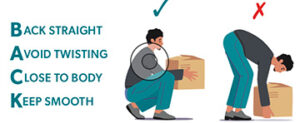 2. Lifting/lowering and carrying
2. Lifting/lowering and carrying
- Test weight — lift within personal limits; use lifting aid or partner; and use correct lifting techniques (BACK)
- Ensure adequate grip and stable base
3. Push/pull
- Push rather than pull
- Use correct equipment (type and size of snow/ice removal tool)
- Ensure equipment is properly maintained (lubrication, tire inflation, handles, etc.)
- Ensure load is stable, evenly distributed, and appropriate weight
4. Climbing – ladder, scaffolding, etc.
- Ensure it is in good repair with no loose hinges, rungs, or screws
- Place on a firm, level surface, and be sure it is erected correctly
- Always ascend and descend facing toward the ladder or scaffolding
- Abide by manufactures recommended work heights
- Always work with a partner for additional stability and safety
Snow Removal
- More than just clearing driveways and walkways – also snow from vehicles, deck/patio, roof, etc.
- Snow removal may be a job requirement — as the main task or as an additional task that is part of the job
Proceed with Caution!
May be hazardous due to over exertion, physical limitations, or working conditions
- Cardiovascular issues — Heart attack, stroke, etc.
- Back issues
- Sedentary and/or deconditioned individuals
- Slips and falls
PREPARE... WE KNOW SNOW IS COMING!
Check weather forecast often — allow extra time based on forecast
- Dress warm: layers — turtleneck, face protection, head protection, gloves/mitts, etc.
- Wear proper footwear — waterproof boots with slip-resistant soles, snow/ice cleats, etc.
- Make sure vision is unobstructed
- Physically warm-up: walk or move for 3-5 minutes prior to beginning; prepare specific muscles
- Store snow removal devices (shovels, snow blower, etc.) in convenient locations
Shovelling Snow
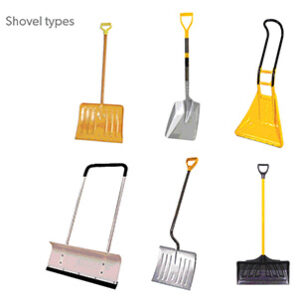 Select the right shovel:
Select the right shovel:
- Purchase the correct shovel for the correct job -— have several different sizes and types of shovels available
- Correct weight and construction — steel/metal shovels are heavier than plastic or fiberglass
- Blade that is correct for specific use:
- size: smaller - used for throwing snow
- size: larger and flat - used for pushing snow
- size: wider and deeper - used for light snow
- size: very small - used for hard, heavy, wet snow
- Blade composition — plastic is lighter but not as strong as metal
- Blade surface — slick surface helps snow slide off freely – prepare surface with ski wax, car wax, cooking oil, etc., prior to use
- Avoid blades with metal edges when pushing along uneven or cracked surfaces — may catch and cause sudden stops
- Shaft — if contoured or bent must fit the size of user
- The handle should come up to one’s chest height to reduce forward bending.
Shovelling technique
- Clear snow early and often; do not wait for all of the snow to fall before shovelling
- Take regular breaks; shovelling should not last longer than 15 minutes followed by a short break
- Fresh snow is fluffy, light, and easier to move than heavily packed or wet snow
- Wet, heavy snow should be lifted in smaller loads
- Move snow farther away early in the winter providing additional space for when snow accumulates
- Create path down center of driveway then push snow out toward each side
- Push a lot and lift a little — wide blade for pushing snow and small blade for lifting snow
- Throw snow as little as possible: do not throw too high or too far
- Avoid awkward throwing postures
- Do not throw snow over shoulder or to the side
- Reposition feet to face the direction the snow will be moved
- Half fill the shovel, bend with knees, keep back straight and lift with legs
- Walk to where the snow will be placed
- Keep snowbanks at even height — creates consistent lifting height — may need to remove snowbanks later in winter
- Be mindful of ice — take smaller steps in icy conditions — be wary of light snow covering potential ice beneath
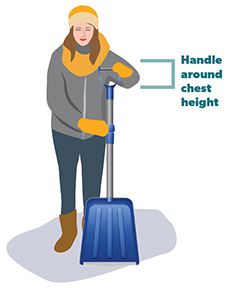
Shovelling the Driveway
- Clear a strip down the middle of the driveway
- Push the snow towards the outer edge
- Repeat on the opposite side
- Lift and throw accumulated snow(if necessary) while facing snow bank
Snow Blowers and Electric/Power Shovels
Powered snow removal devices may be helpful depending upon the amount and type of snow present as well as the distance the snow is required to be moved. Snow blowers are often large and heavy, and sometimes difficult to start. Electric/Power shovels are smaller but may also be heavy and awkward to utilize.
- Follow user instructions
- Keep properly maintained
- Clear snow early and often; do not wait for all of the snow to fall before removing
- Utilize powered snow removal devices prior to snow becoming packed and hard
- Take regular breaks; snow removal should not last longer than 15 minutes followed by a short break
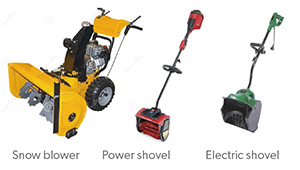
snow blowers
- Use electric start if available
- Choose the correct tool for the job – larger snow blowers may be required for larger areas with more snow; a power shovel may be adequate for smaller areas with less snow
- Do not “push” snow blower, allow it to “pull” or “drive” itself
- Keep the snow blower close to the body
- For larger amounts of snow, take smaller passes
- Be aware of changes in elevation, or difficult to see obstacles
- Vibration: avoid long periods of snow blowing, share the job (job rotation)
- Gripping: depends on the controls, some models have a drive train that only engages when the lever is pressed
- Utilize hearing protection
- If relocation is required utilize ramps or partner to lift or move snow blower
Snow Deposited from Snowplow
Most snowplows follow a designated plow schedule. Learn the schedule so that snow can be removed as soon as possible once the plow has passed.
- Easiest to remove prior to it freezing, hard frozen snow is heavy and difficult to break up
- Utilize small or half full shovel scoops
- Move snow farther away early in the winter providing additional space for when snow accumulates
- Cut down snowbanks often to decrease height required to lift snow
Walking or Working on Icy or Snow-Covered Areas
- As winter progresses walkways and driveways become increasingly more icy and slippery.
- When walking and/or working in slippery conditions wear appropriate nonslip footwear – add ice/snow cleats to footwear if required
- Sand or salt icy areas
- Monitor conditions – salt/sand prior to the surface becoming dangerous
- Bags of salt/sand may be heavy depending on size – break into smaller containers and store close to areas of need
- Use a scoop to sprinkle salt/sand on surface (steps, driveway, sidewalk, etc.)
- For larger areas consider using a push behind spreader
Cleaning Vehicles
Check weather forecast often — allow extra time based on forecast
- Clean as soon as possible — fresh snow is lighter and easier to clean
- Snow scrapers — keep one in vehicle and one in house or garage — so vehicle may be cleaned without needing to enter vehicle
- Longer snow scrapers help decrease reaching and twisting
- Use windshield wiper fluid stored in squirt containers to loosen ice on windows and windshield — store within house or garage
Hanging Holiday Lights and Removing Snow from Roof
Hang holiday lights as early in the season as possible to avoid poor weather and slippery conditions
Clean snow from roof as early as possible — once it is determined that roof removal is/will be required
- Always follow all recommended safety guidelines set out for ladder use. More info here.
- Always perform this with a partner – one person holds ladder while upright and helps with its relocation
- Move ladder frequently to avoid overreaching – always keep body centred on the rungs of the ladder, do not lean to the side or reach more than an elbows distance away
Using a “roof rake” to pull snow from a roof requires less movement of the ladder but may increase strength and reach requirements as well as danger of falling snow


Comments are closed.